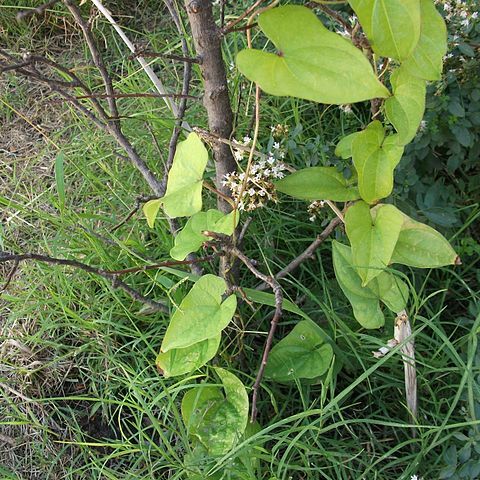Tubers vertical, long cylindric, to 3 cm in diam.; cork yellowish brown; transverse section white or yellowish white. Stem twining to right, green, sometimes light purplish red. Bulblets often present. Leaves alternate basally on stem, opposite distally on stem, simple; petiole 1.5--4(--6) cm; leaf blade drying yellowish green to light brownish, broadly ovate basally on stem, usually triangular-lanceolate to linear distally on stem, 3--12(--19) × 1--6(--18) cm, membranous or papery, glabrous, basal veins 5--9, base sagittate or hastate to cordate or ± truncate, margin entire, apex acute to long acuminate. Male spikes 3--5 together, rarely solitary, ± erect or ascending, 2--8 cm; rachis straight, occasionally slightly zigzagged at apex. Male flowers: perianth greenish white or light yellow, lobes purple spotted, ovate or ovate-elliptic, to 2 × 1.5 mm, inner ones smaller than outer; stamens 6. Female spikes solitary or 2 or 3 together, 6--20 cm. Female flowers: staminodes 6. Capsule not reflexed, pale brown with darker, linear freckles, oblate, 1.5--2(--2.5) cm, base truncate, apex emarginate; wings 0.7--1.5(--2) cm wide, margin dark. Seeds inserted near middle of capsule, D-shaped, ca. 1.9 cm (ca. 0.7 cm excluding wing), winged all round. Fl. May--Oct, fr. Jul--Nov.
More
A yam. The stem twines to the right. The tubers are vertical and like a cylinder and 3 cm across. They are brown on the outside and white inside. The lower leaves are alternate and the higher leaves are opposite. They are elongated and irregular and 5-10 cm long by 2-5 cm wide.
A temperate to subtropical plant. It grows in high mountains and on the edges of forests. In China it grows on mountain slopes and along river valleys between 100-1,200 m above sea level. It suits hardiness zones 4-10. In Sichuan.
More
Wooded foothills. Mixed forests and margins, scrub forests, herb communities, mountain slopes, valleys, along rivers and streams, roadsides; 100-1200 metres.

